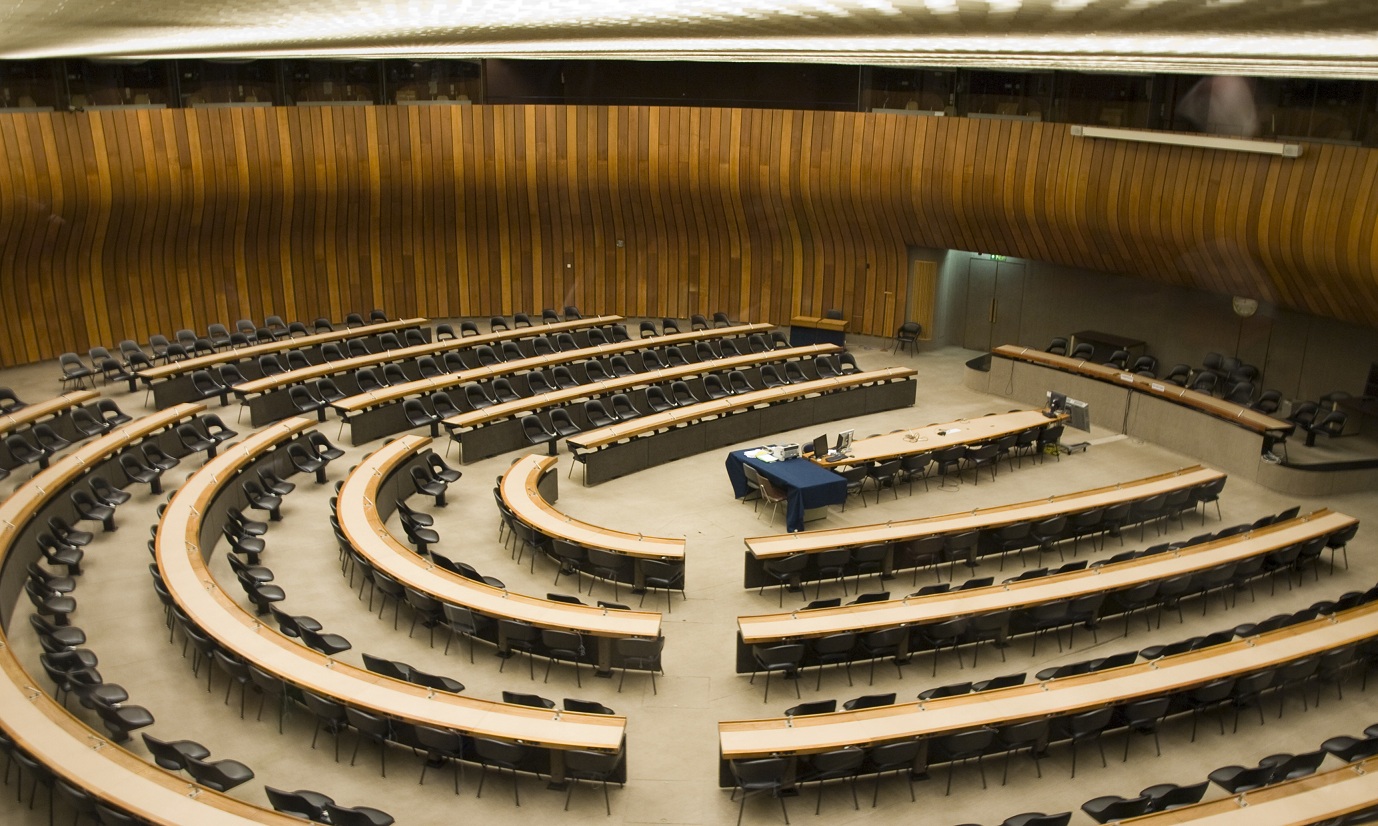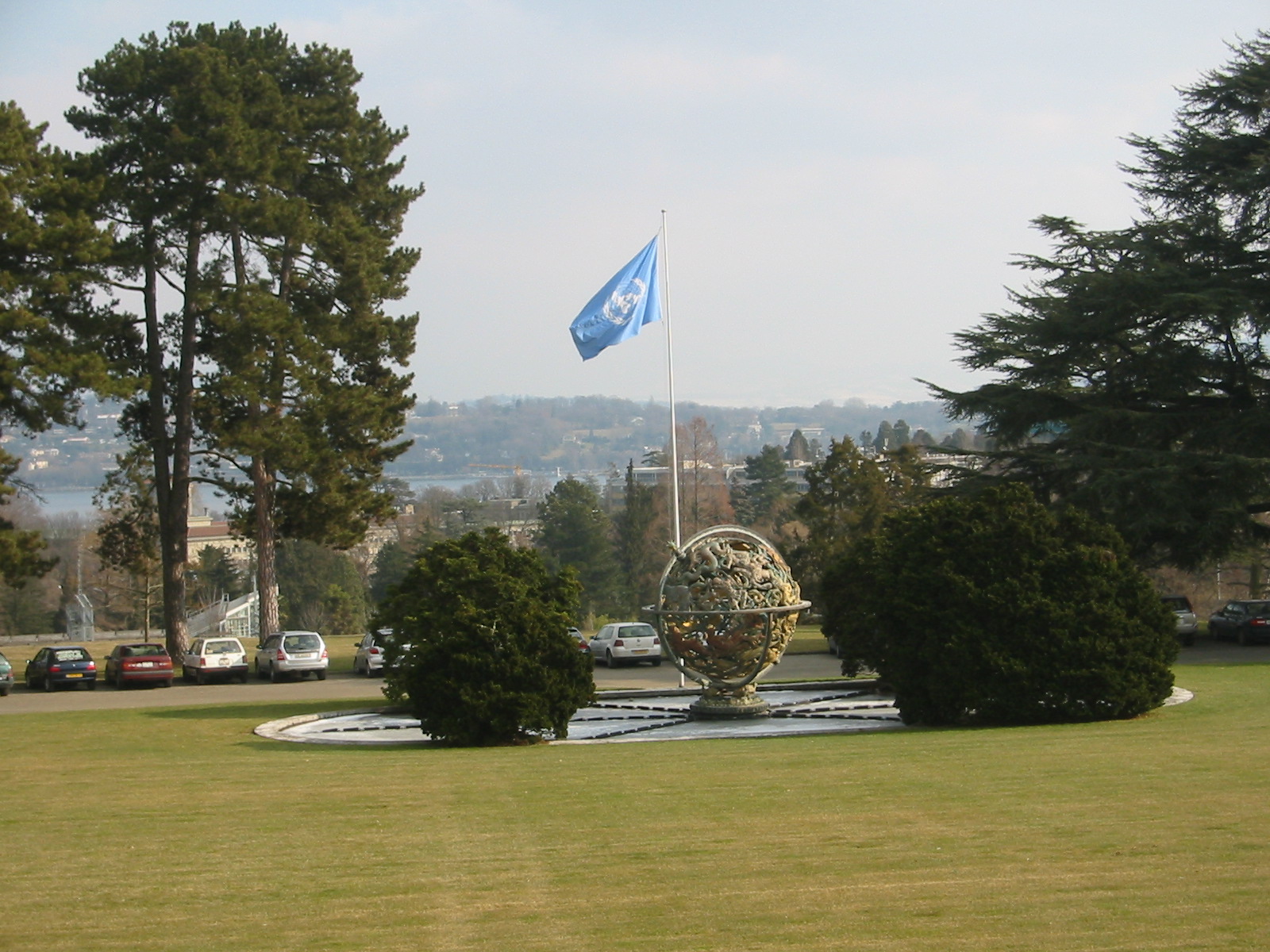Palace of Nations, Geneva on:
[Wikipedia]
[Google]
[Amazon]
 The Palace of Nations (french: Palais des Nations, ) is the home of the
The Palace of Nations (french: Palais des Nations, ) is the home of the
 The Palace is located in Ariana Park, which was bequeathed to the City of Geneva in 1890 by , on two conditions: i.e., that the park always remain accessible to the public and that he be buried in the park. The park also contains a 1668
The Palace is located in Ariana Park, which was bequeathed to the City of Geneva in 1890 by , on two conditions: i.e., that the park always remain accessible to the public and that he be buried in the park. The park also contains a 1668
United Nations Office at Geneva
Palais des Nations
{{DEFAULTSORT:Palace of Nations 1938 establishments in Switzerland Buildings and structures completed in 1938 Buildings and structures in Geneva Diplomatic buildings League of Nations Neoclassical architecture in Switzerland Office buildings completed in 1936 Palaces in Switzerland Switzerland and the United Nations Tourist attractions in Geneva United Nations properties
 The Palace of Nations (french: Palais des Nations, ) is the home of the
The Palace of Nations (french: Palais des Nations, ) is the home of the United Nations Office at Geneva
The United Nations Office at Geneva (UNOG, french: Office des Nations Unies à Genève) in Geneva, Switzerland, is one of the four major offices of the United Nations where numerous different UN agencies have a joint presence. The main UNOG ...
, located in Geneva
Geneva ( ; french: Genève ) frp, Genèva ; german: link=no, Genf ; it, Ginevra ; rm, Genevra is the List of cities in Switzerland, second-most populous city in Switzerland (after Zürich) and the most populous city of Romandy, the French-speaki ...
, Switzerland
). Swiss law does not designate a ''capital'' as such, but the federal parliament and government are installed in Bern, while other federal institutions, such as the federal courts, are in other cities (Bellinzona, Lausanne, Luzern, Neuchâtel ...
. It was built between 1929 and 1938 to serve as the headquarters of the League of Nations
The League of Nations (french: link=no, Société des Nations ) was the first worldwide intergovernmental organisation whose principal mission was to maintain world peace. It was founded on 10 January 1920 by the Paris Peace Conference that ...
. It has served as the home of the United Nations Office at Geneva since 1946 when the Secretary-General of the United Nations
The secretary-general of the United Nations (UNSG or SG) is the chief administrative officer of the United Nations and head of the United Nations Secretariat, one of the six principal organs of the United Nations.
The role of the secretary-g ...
signed a Headquarters Agreement with the Swiss authorities, although Switzerland did not become a member of the United Nations
The United Nations (UN) is an intergovernmental organization whose stated purposes are to maintain international peace and international security, security, develop friendly relations among nations, achieve international cooperation, and be ...
until 2002.
In 2012 alone, the Palace of Nations hosted more than 10,000 intergovernmental meetings.
History
Project and construction
An architectural competition held in the 1920s to choose a design for the complex described the project as follows:The Palace, whose construction is the object of the competition, is intended to house all the organs of the League of Nations in Geneva. It should be designed in such a way as to allow these organs to work, to preside and to hold discussions, independently and easily in the calm atmosphere which should prevail when dealing with problems of an international dimension.A jury of nine architects was selected to choose a final design from among 377 entries:
Hendrik Petrus Berlage
Hendrik Petrus Berlage (21 February 1856 – 12 August 1934) was a Dutch architect. He is considered one of the fathers of the architecture of the Amsterdam School.
Life and work
Hendrik Petrus Berlage, son of Nicolaas Willem Berlage and An ...
, Victor Horta
Victor Pierre Horta (; Victor, Baron Horta after 1932; 6 January 1861 – 8 September 1947) was a Belgian architect and designer, and one of the founders of the Art Nouveau movement. His Hôtel Tassel in Brussels, built in 1892–93, is often ...
, Josef Hoffman
Josef Hoffmann (15 December 1870 – 7 May 1956) was an Austrian- Moravian architect and designer. He was among the founders of Vienna Secession and co-establisher of the Wiener Werkstätte. His most famous architectural work is the Stoclet P ...
, Charles Lemaresquier, John James Burnet
Sir John James Burnet (31 May 1857 – 2 July 1938) was a Scottish Edwardian architect who was noted for a number of prominent buildings in Glasgow and London. He was the son of the architect John Burnet, and later went into partnership with ...
, Attilio Muggia, Ivar Tengbom
Ivar Justus Tengbom (April 7, 1878 – August 6, 1968) was a Swedish architect and one of the best-known representatives of the Swedish neo-classical architecture of the 1910s and 1920s.
Tengbom was born in Vireda in Jönköping County, stu ...
, Carlos Gato of Madrid, and Karl Moser
Karl Moser (August 10, 1860 – February 28, 1936) was an architect from Switzerland.
Between 1887 and 1915 he worked together with Robert Curjel in Karlsruhe, setting up the architecture firm Curjel and Moser. Some of their works are:
...
. The jury was unable to choose a single winner. Ultimately, the five architects behind the leading entries were chosen to collaborate on a final design: Julien Flegenheimer of Switzerland, Camille Lefèvre and Henri-Paul Nénot of France, Carlo Broggi of Italy and József Vágó of Hungary. Donations from League members were used in the interior.
Completion (1936)
The Palace constituted at the time of completion (1936), volume wise, the second-largest building complex in Europe afterVersailles
The Palace of Versailles ( ; french: Château de Versailles ) is a former royal residence built by King Louis XIV located in Versailles, about west of Paris, France. The palace is owned by the French Republic and since 1995 has been managed, u ...
( vs. ).
Expansion for the UN
After its transfer to the United Nations, two extensions were added to the building, which considerably increased the size of the usable area of the building. Between 1950 and 1952, three floors were added to the "K" building, and the "D" building was constructed to house temporarily theWorld Health Organization
The World Health Organization (WHO) is a specialized agency of the United Nations responsible for international public health. The WHO Constitution states its main objective as "the attainment by all peoples of the highest possible level of h ...
. The "E" building (or "New" Building) was added between 1968 and 1973 as a conference facility (an additional eleven conference rooms and an extra volume of ), bringing the total number of conference rooms to 34. With the additions, the complex is long and holds 2,800 offices, with a total volume of
In December 1988, in order to hear Yasser Arafat
Mohammed Abdel Rahman Abdel Raouf al-Qudwa al-Husseini (4 / 24 August 1929 – 11 November 2004), popularly known as Yasser Arafat ( , ; ar, محمد ياسر عبد الرحمن عبد الرؤوف عرفات القدوة الحسيني, Mu ...
, the United Nations General Assembly
The United Nations General Assembly (UNGA or GA; french: link=no, Assemblée générale, AG) is one of the six principal organs of the United Nations (UN), serving as the main deliberative, policymaking, and representative organ of the UN. Curr ...
moved its 43rd session from the United Nations Headquarters in New York
zh, 联合国总部大楼french: Siège des Nations uniesrussian: Штаб-квартира Организации Объединённых Наций es, Sede de las Naciones Unidas
, image = Midtown Manhattan Skyline 004.jpg
, im ...
to the Palace of Nations.
Description
 The Palace is located in Ariana Park, which was bequeathed to the City of Geneva in 1890 by , on two conditions: i.e., that the park always remain accessible to the public and that he be buried in the park. The park also contains a 1668
The Palace is located in Ariana Park, which was bequeathed to the City of Geneva in 1890 by , on two conditions: i.e., that the park always remain accessible to the public and that he be buried in the park. The park also contains a 1668 chalet
A chalet (pronounced in British English; in American English usually ), also called Swiss chalet, is a type of building or house, typical of the Alpine region in Europe. It is made of wood, with a heavy, gently sloping roof and wide, well-suppo ...
.
Beneath the Palace's foundation stone is a time capsule
A time capsule is a historic cache of goods or information, usually intended as a deliberate method of communication with future people, and to help future archaeologists, anthropologists, or historians. The preservation of holy relics dates ba ...
containing a document listing the names of the League of Nations member states, a copy of the Covenant of the League, and specimen coins of all the countries represented at the league's Tenth Assembly. A medal showing the Palace of Nations with the Jura Mountains
The Jura Mountains ( , , , ; french: Massif du Jura; german: Juragebirge; it, Massiccio del Giura, rm, Montagnas da Jura) are a sub-alpine mountain range a short distance north of the Western Alps and mainly demarcate a long part of the Frenc ...
in the background was struck in silvered bronze.
The building overlooks Lake Geneva
, image = Lake Geneva by Sentinel-2.jpg
, caption = Satellite image
, image_bathymetry =
, caption_bathymetry =
, location = Switzerland, France
, coords =
, lake_type = Glacial lak ...
and has a clear view of the French Alps
The French Alps are the portions of the Alps mountain range that stand within France, located in the Auvergne-Rhône-Alpes and Provence-Alpes-Côte d'Azur regions. While some of the ranges of the French Alps are entirely in France, others, such as ...
.
Image gallery
References
Further reading
*External links
United Nations Office at Geneva
Palais des Nations
{{DEFAULTSORT:Palace of Nations 1938 establishments in Switzerland Buildings and structures completed in 1938 Buildings and structures in Geneva Diplomatic buildings League of Nations Neoclassical architecture in Switzerland Office buildings completed in 1936 Palaces in Switzerland Switzerland and the United Nations Tourist attractions in Geneva United Nations properties